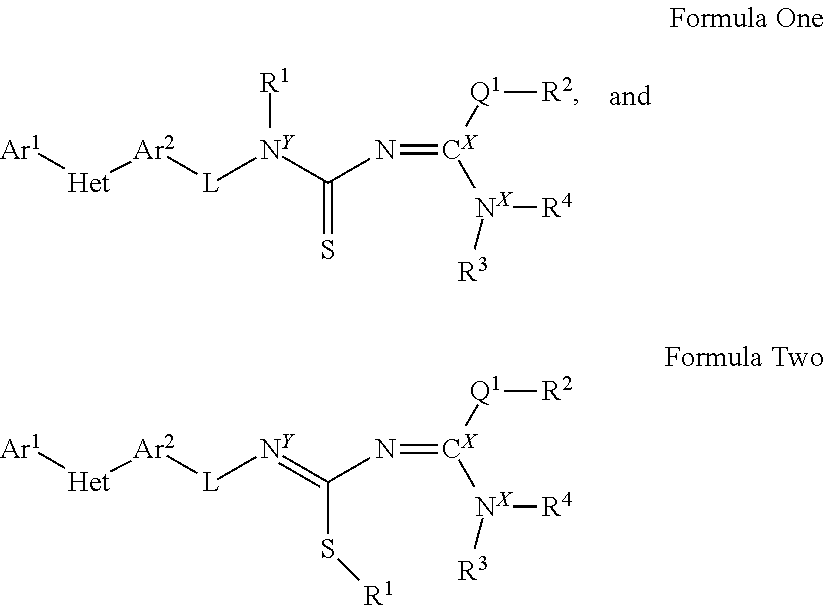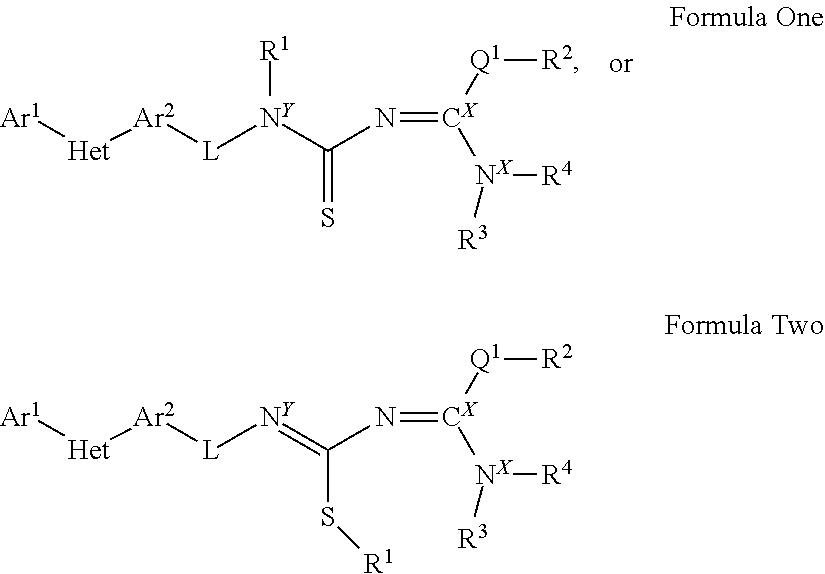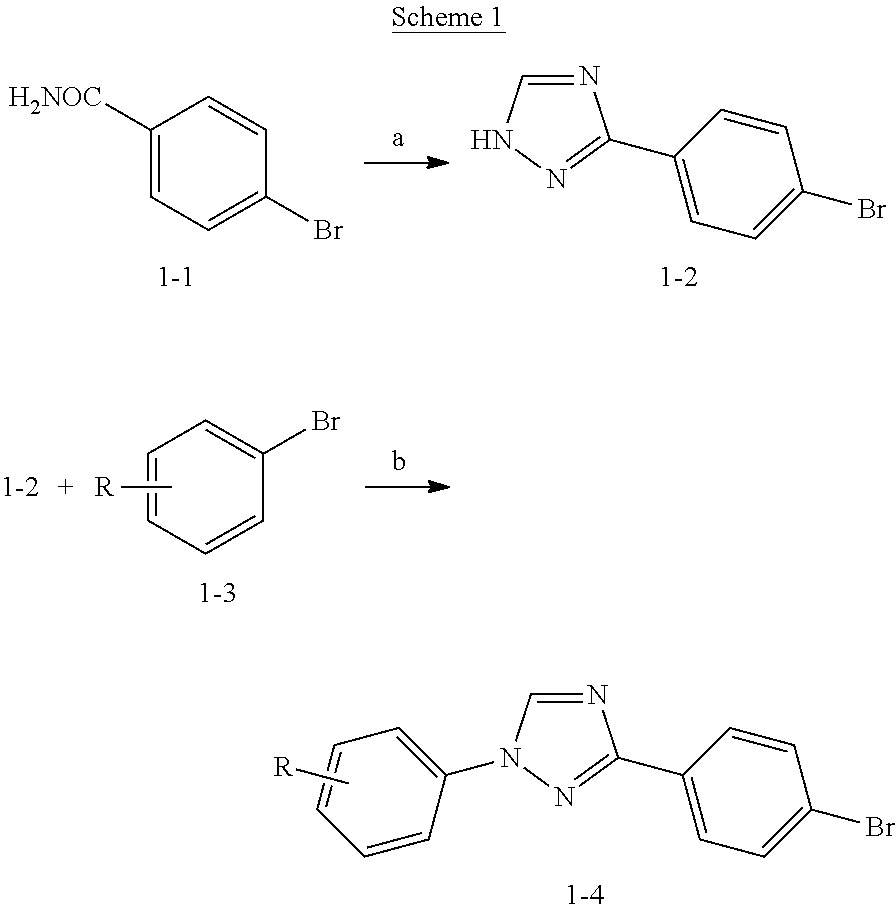Molecules having certain pesticidal utilities, and intermediates, compositions, and processes related thereto
a technology of pesticidal utilities and molecules, applied in the field of molecules, can solve the problems of destroying more than 40% of all potential food production by weeds, prone to loss, and often one of the most insidious and costly problems
- Summary
- Abstract
- Description
- Claims
- Application Information
AI Technical Summary
Benefits of technology
Problems solved by technology
Method used
Image
Examples
example 1
on of 3-(4-bromophenyl)-1-(4-(trifluoromethoxy)phenyl)-1H-1,2,4-triazole
[0096]
[0097]To 3-(4-Bromophenyl)-1H-1,2,4-triazole (14.52 grams (g), 64.8 millimoles (mmol)), copper(I) iodide (CuI; 3.55 g, 18.6 mmol), and cesium carbonate (39.0 g, 120 mmol) in a round-bottomed flask were added dimethyl sulfoxide (DMSO; 100 milliliters (mL)) and 1-iodo-4-(trifluoromethoxy)benzene (16.63 g, 57.7 mmol). The reaction mixture was degassed for 5 minutes (min) and then heated overnight at 100° C. The reaction mixture was cooled to room temperature, diluted with ethyl acetate (EtOAc), and filtered through Celite®. The Celite® cake was washed with EtOAc. Saturated (satd) ammonium chloride (NH4Cl) solution was added to the filtrate and the mixture was stirred for 1 hour (h). The layers were separated and the aqueous layer was extracted with EtOAc (3×). The combined organic layers were dried over anhydrous magnesium sulfate (MgSO4) and concentrated onto Celite®. Purification by flash chromatography (0-...
example 2
on of tert-butyl (4-(1-(4-(trifluoromethoxy)phenyl)-1H-1,2,4-triazol-3-yl)phenethyl)carbamate
[0098]
[0099]A mixture of 3-(4-bromophenyl)-1-(4-(trifluoromethoxy)phenyl)-1H-1,2,4-triazole (5.15 g, 13.4 mmol), potassium (2-((tert-butoxycarbonyl)amino)ethyl)trifluoroborate (3.37 g, 13.4 mmol), dicyclohexyl(2′,6′-diisopropoxy-[1,1′-biphenyl]-2-yl)phosphine (634 milligrams (mg), 1.36 mmol), palladium(II) acetate (249 mg, 1.1 mmol), and cesium carbonate (13.52 g, 41.5 mmol) in toluene / water (4:1; 125 mL) was heated at 95° C. over the weekend. The reaction mixture was cooled to room temperature and filtered through Celite® rinsing with EtOAc. The layers were separated and the aqueous layers were extracted with EtOAc. The combined organic layers were dried over anhydrous MgSO4, filtered, and concentrated. Purification by flash column chromatography (0-50% EtOAc / hexanes) provided the desired compound as an off-white solid (5.23 g, 83%): mp 149-153° C.; 1H NMR (400 MHz, CDCl3) δ 8.55 (s, 1H), 8...
example 3
on of 2-(4-(1-(4-(trifluoromethoxy)phenyl)-1H-1,2,4-triazol-3-yl)phenyl)ethan-1-aminium 2,2,2-trifluoroacetate
[0100]
[0101]To tert-butyl 4-(1-(4-(trifluoromethoxy)phenyl)-1H-1,2,4-triazol-3-yl)phenethylcarbamate (0.48 g, 1.07 mmol) in dichloromethane (5.4 mL) was added trifluoroacetic acid (TFA; 0.25 mL, 3.2 mmol) and the mixture was stirred at room temperature overnight. Liquid chromatography-mass spectrometry (LC-MS) analysis showed a 2:1 mixture of starting material-product, so additional TFA (0.25 mL, 3.2 mmol) was added. The mixture was stirred overnight at room temperature. The reaction mixture was concentrated and dried in the vacuum oven to provide the desired compound as a yellow solid (803 mg, 100%): 1H NMR (400 MHz, DMSO-d6) δ 9.41 (s, 1H), 8.17-7.99 (m, 4H), 7.88 (s, 3H), 7.66-7.60 (m, 2H), 7.43 (dd, J=8.5, 2.3 Hz, 2H), 3.11 (dt, J=8.7, 5.9 Hz, 2H), 2.94 (dd, J=9.3, 6.4 Hz, 2H); 19F NMR (376 MHz, DMSO-d6) δ−57.00, −74.71, −74.85; 13C NMR (101 MHz, DMSO-d6) δ 161.90, 147.1...
PUM
| Property | Measurement | Unit |
|---|---|---|
| temperature | aaaaa | aaaaa |
| temperature | aaaaa | aaaaa |
| temperatures | aaaaa | aaaaa |
Abstract
Description
Claims
Application Information
 Login to View More
Login to View More - R&D
- Intellectual Property
- Life Sciences
- Materials
- Tech Scout
- Unparalleled Data Quality
- Higher Quality Content
- 60% Fewer Hallucinations
Browse by: Latest US Patents, China's latest patents, Technical Efficacy Thesaurus, Application Domain, Technology Topic, Popular Technical Reports.
© 2025 PatSnap. All rights reserved.Legal|Privacy policy|Modern Slavery Act Transparency Statement|Sitemap|About US| Contact US: help@patsnap.com



